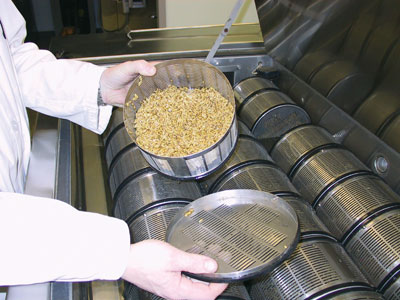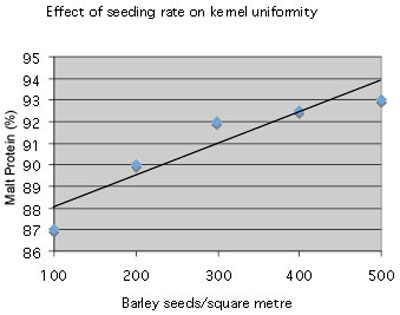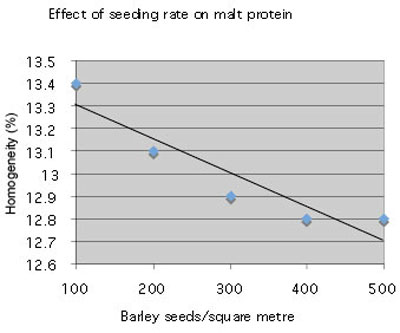
Features
Agronomy
Seeding/Planting
Growing better malt barley: improving quality through agronomics
Malting barley is an important crop for many growers in Western Canada, but achieving malt quality can be challenging.
March 17, 2010 By Donna Fleury
Malting barley is an important crop for many growers in Western Canada, but achieving malt quality can be challenging.

|
| Research found that seeding at around 300 seeds per square metre provided optimum malt quality. (Photo courtesy of Canadian Grains Commission, Grains Research Laboratory)
|
There are several important quality parameters that maltsters and brewers require for barley to be accepted for malting quality, including low protein (11 to 12.5 percent), high malt extract levels, low beta-glucan, high friability and homogeneity, among others. Researchers wanted to determine which agronomic practices influence malt quality and ultimately malting and brewing. The results of a recent three-year study answered some of these questions for researchers, but raised others. “A three-year study was conducted at eight locations across Western Canada, comparing two malt barley varieties, AC Metcalfe, the most widely grown malting variety in Western Canada, and CDC Copeland, the second most widely grown variety,” explains Dr. John O’Donovan, research scientist with Agriculture and Agri-Food Canada (AAFC) at Lacombe, Alberta. “Several agronomic factors on malt barley productivity and quality were compared, including seeding date, seeding rate, nitrogen rate, previous stubble and fungicide application.”
The research project, in collaboration with the Canadian Grain Commission’s Grain Research Laboratory, combined the agronomic research with a micro-malt assessment process allowing researchers for the first time to take the samples right to final malting quality to measure the impacts. Other project partners included the Alberta Barley Commission, the Canadian Wheat Board and RAHR Malting Canada Ltd. “Over the three years of the study, the results and trends were consistent for all of the parameters,” says O’Donovan. “There were three agronomic practices that we found to be really of significance for quality in the research, including seeding rates, seeding dates and nitrogen (N) application rates. We have developed some general recommendations for growers for some practices, but factors such as N rates require more research.”
Finding the optimum seeding rate
One of the important findings was the impact of seeding rate on malt barley quality, including plumpness. Plumpness is an important factor in selecting barley for malt, with plump seeds generally having higher starch and lower protein levels. The research had shown that although there was a reduction in plumpness as seeding rates were increased, overall there were several other positive results. “One of the most interesting findings is that although we did notice a significant drop in plumpness as seeding rates were increased, there was no effect on the extract,” explains Dr. Mike Edney, program manager of Applied Barley Research at CGC. “The reason plumpness is so important is that maltsters want to produce more extract, which means more beer. However, our analysis confirmed that increased seeding rates didn’t have a negative effect on end-use quality even though it had an effect on plumpness.”
Higher seeding rates resulted in more uniformity of barley kernels, which improves the modification process and produces higher quality malt. “Uniformity is very important, although we have to strike a balance between uniformity and plumpness,” says O’Donovan. “Higher seeding rates also reduced beta-glucan levels, while friability and homogeneity were improved, all positive factors for malsters.”
By increasing seeding rates, the days to maturity were also shortened.
Edney also used a technique called the Single Kernel Characterization System, to measure and confirm the uniformity of individual kernels. “This system looks at 300 individual kernels and measures weight, diameter, moisture and hardness, which provides a standard deviation or the amount of variability among those 300 kernels,” explains Edney. “This technique confirmed that higher seeding rates really kept that standard deviation or variability significantly lower than at lower seeding rates, especially with respect to kernel size.”
Once those measurements were completed, Edney took the samples through the malting process. “We found that even though the plumpness was reduced, the greater uniformity of size led to better malt quality, which is probably why the final malt extract wasn’t affected. The beta-glucan levels were not only significantly lower at higher seeding rates, but other indices show that the beta-glucan was more uniformly broken down in the modification process, improving the malt quality.” Edney is still completing some experiments from the 2009 growing season, and expects to have more results in a few months.
|
|
“As a result of both the agronomic research and the micro-malt assessment work, we have concluded that, as a general rule of thumb, growers should target a seeding rate of 300 seeds per square metre for malting barley, which will result in about 200 to 220 plants per square meter in most cases,” adds O’Donovan. “This seeding rate is what growers should aim for to achieve better malt quality.”
Earlier seeding improves quality
The research showed that seeding dates can also impact malt barley quality. Although growers tend to seed crops such as wheat and canola earlier than barley because they take longer to mature, the research shows that seeding malt barley early can improve the quality. “There are many factors involved in crop establishment and although there were a few exceptions, as a general rule of thumb, earlier seeding dates produced better quality malt.”
The third most important factor, but the one posing the most challenges and additional questions to researchers, is related to N. “We know that N is very important for increasing yields, and in most cases rates of up to 120 kg per hectare (107 lbs per acre) result in an increase in barley yields,” explains O’Donovan. “However, the effect of higher N on malt quality is mostly negative.”
N rates need more study
Higher N usually increases protein levels, but at protein levels higher than 12.5 percent, the sample will be rejected for malt. Higher N rates also increase beta-glucan levels, while other factors such as plumpness, friability and modification are decreased at higher N rates, all having negative impacts on quality. Higher N rates sometimes increase the days to a maturity, which can cause problems in years where there is a higher risk of frost or other conditions that will reduce malt barley quality.
Although the research shows that reducing N rates will improve malt barley quality, researchers have not been able to determine the most appropriate rates. “This is probably one of the toughest decisions we’re facing, and we need more research to be able to provide good N guidelines to growers,” explains O’Donovan. “One of the things we’re hoping to look at in future projects is whether or not we can reduce the negative effect of N on quality without compromising yields too much.” One interesting discovery in the research is that of the two varieties, AC Copeland is not as affected by N rates as much as AC Metcalf was. That indicates there may be differences among varieties, and researchers are hoping to screen some of the newer varieties in the pipeline at different rates of N to compare the effects on quality.
O’Donovan would also like to look at alternative fertilizer practices such as split applications of N or using new technology such as GreenSeeker Technology as potential options for managing N without reducing quality. “We also want to look at the effect of having legumes in rotation on quality,” adds O’Donovan. “Another area to consider is the effect of using bin-run seed compared to certified seed and whether or not that has an impact on quality.”
Researchers hope to have funding to put these projects in place and be able to provide more specific recommendations to growers on N rates and impacts over the next few years. “For now, the research so far confirms that seeding rates, seeding dates and N rates are three significant agronomic practices that growers can use to improve the likelihood their barley will be accepted for malt quality.”

